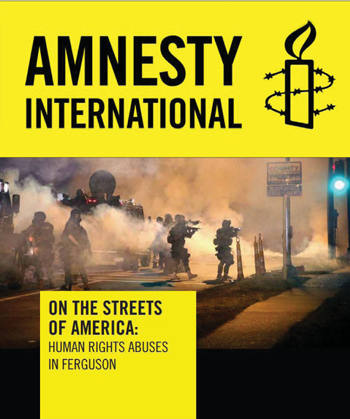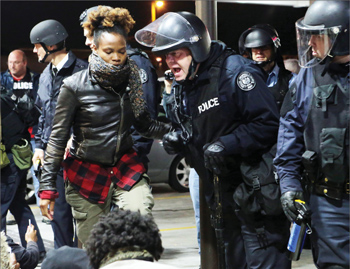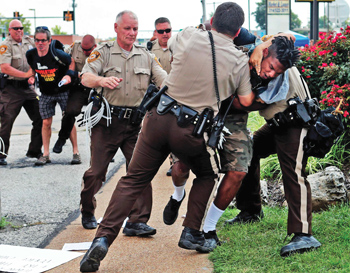
What's your opinion on this article?

|
Amnesty released the report as protests continued amid demands for justice for Michael Brown, an unarmed 18-year-old shot to death in Ferguson, Mo., in August by Darren Wilson, a White police officer.
The report, which came out in October, raised questions about the use of force in the death of Mr. Brown, mistreatment of protestors, denial of the right to protest, expressed concern about military-style gear worn and used by officers, threats made by officers and called on the United States to address longstanding problems of racial discrimination and police brutality. The Brown killing follows a pattern of discriminatory and fatal police encounters with Blacks, the report said.
The events in Ferguson raised “a range of human rights concerns, including the right to life, the use of lethal force by law enforcement, the right to freedom from discrimination, and the rights to freedom of expression and assembly,” the report said.

A police officer dressed in riot gear gives the final warning to move or be arrested to a group of roughly 50 protesters conducting a sit-in at the QuikTrip, Sunday, Oct 12, 2014, in St. Louis. Seventeen people were arrested during weekend protests, St. Louis police said Sunday, and more demonstrations were planned over the shooting of 18-year-old Michael Brown in Ferguson this summer.
“The United States government must do much more to address systemic racial discrimination and ensure policing practices nationwide are brought into line with international human rights standards.” —Amnesty International |
According to police statements, a physical confrontation between officer Wilson and the teen resulted in the officer shooting the young man.
“Irrespective of whether there was some sort of physical confrontation between Michael Brown and the police officer, Michael Brown was unarmed and thus unlikely to have presented a serious threat to the life of the police officer. As such, this calls into question whether the use of lethal force was justified, and the circumstances of the killing must be urgently clarified,” said the report released on Oct. 23.
Additionally Missouri’s broad statute on the use of deadly force may be “unconstitutional and is clearly out of line with international standards on the intentional use of lethal force as it goes well beyond the doctrine that lethal force only be used to protect life,” it added.
“The United States government must do much more to address systemic racial discrimination and ensure policing practices nationwide are brought into line with international human rights standards,” said Amnesty. “For years, the monitoring of police conduct and excessive use of force has been hampered by the failure of the Department of Justice to collect accurate, comprehensive national data on police use of force, including the numbers of people killed or injured through police shootings or other types of force. Because this data is not being consistently collated at a national level, no one currently knows how many people are shot and killed by police officers in the United States,” the report concluded.

Police tackle a man who was walking down the street in front of McDonald's on Aug. 18, in Ferguson, Mo. The man appeared to be walking past a group that had been assembled nearby and police were telling everyone to keep walking. Moments after he turned around and exchanged words with the police that he was just walking, police took him to the ground.
“The use of heavy-duty riot gear and military-grade weapons and equipment to police largely peaceful demonstrations intimidates protesters who are practicing their right to peaceful assembly and can actually lead to an escalation in violence.” —Amnesty International |
The rights of peaceful assembly, freedom of association and freedom of expression were basic human rights violated during the Ferguson protests.
“Law enforcement in Ferguson and the Missouri government employed several tactics of concern to Amnesty International, including the imposition of a curfew for the entire city of Ferguson which limited the rights of those demonstrating peacefully but also the freedom of movement of the general public and requirements for those protesters on West Florissant Avenue to ‘keep walking’ under threat of arrest, impeded protesters from exercising their right to freely assemble,” the report said.
“Law enforcement also impeded protestors’ right to assemble by closing and occupying the QuikTrip gas station on West Florissant, where many gathered daily, instead, setting up an ‘approved’ assembly area in the parking lot of a car dealership that was no longer in business and set back from the main road. After the ‘keep walking’ rule was imposed on Aug. 18, arrests of protesters for ‘refusal to disperse’ escalated as 85 protesters were arrested under that charge on the nights of Aug. 18 and 19. A number of activists remarked to Amnesty International that they believed the rule was imposed to tire out the protesters in hopes of getting the protests to end earlier in the night,” the report said. Later a court ruled the “keep walking” requirement was invalid.
“Overall, during the 12 days following the death of Michael Brown, 172 arrests were made in the Ferguson protest zone with 132 people charged solely with the crime of refusal to disperse,” Amnesty said.
In the days following Michael Brown’s death, the St. Louis County Police Department initially took over the responsibility for providing security in Ferguson. The St. Louis County officers lined the march routes on West Florissant on Aug. 13 with officers outfitted in riot gear and armed with semi-automatic weapons that were pointed at demonstrators, Amnesty said.
The change in responsibility from the County Police to the Missouri Highway Patrol on Aug. 14 helped de-escalate the tension between residents/protesters and police in Ferguson. However, the resumption of violence by some protesters in the late night hours of Aug. 15 brought a response where, the Highway Patrol, with assistance from the County Police as well as smaller law enforcement agencies from across the state, confronted protesters in riot gear of helmets and vests along with carrying shields and batons, some were armed with semi-automatic weapons, and leashed police dogs, said the human rights organization.
Amnesty observers found themselves facing police weapons when trying to leave the area late in the evening on Aug. 18, after law enforcement fired tear gas and stun grenades to disperse the crowds on the south end of W. Florissant Avenue.
“Shortly before midnight on Aug. 19, Amnesty International witnessed an officer with the St. Ann Police Department in Missouri point his AR-15 semi-automatic rifle at a group of journalists and threatened to kill them. The incident was filmed by a journalist and went viral on Aug. 20. The video shows the officer walking toward a group of protestors with his rifle raised. Voices can be heard telling him to put his gun down. The video shows the officer approaching the crowd with his rifle raised yelling, ‘I’m going to f--king kill you! Get back, get back.’ ”
The officer was immediately placed on indefinite, unpaid suspension and resigned several days later.
“The use of heavy-duty riot gear and military-grade weapons and equipment to police largely peaceful demonstrations intimidates protesters who are practicing their right to peaceful assembly and can actually lead to an escalation in violence. Equipping officers in a manner more appropriate for a battlefield may put them in the mindset that confrontation and conflict is inevitable rather than possible, escalating tensions between protesters and police,” Amnesty said.
The use of tear gas, pepper spray, rubber and plastic bullets against demonstrators was also questioned. Officers failed to enforce orders to disperse in a consistent manner and there are also questions about whether the orders to disperse were legal, said Amnesty.
Police also activated a Long Range Acoustic Device (LRAD), which when used at close range, loud volume or excessive lengths of time can pose serious “health risks, ranging from temporary pain, loss of balance and eardrum rupture, to permanent hearing damage,” Amnesty noted.
Legal, human rights observers and members of the media were repeatedly “obstructed from carrying out their roles and responsibilities by law enforcement in Ferguson,” Amnesty said. Reporters were subjected to tear gas, rubber bullets, arrest and had weapons pointed at them, the group added.